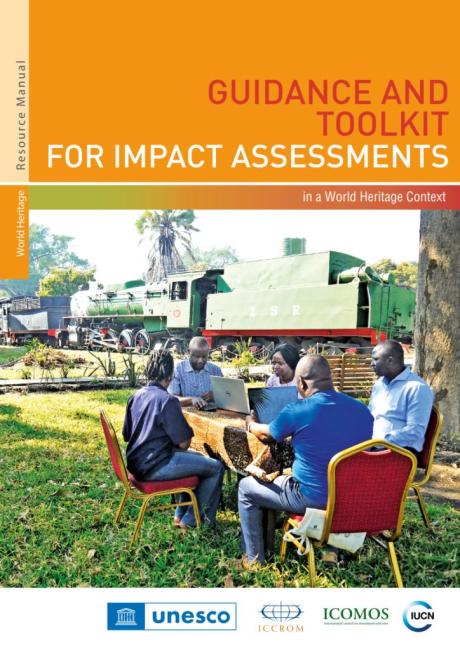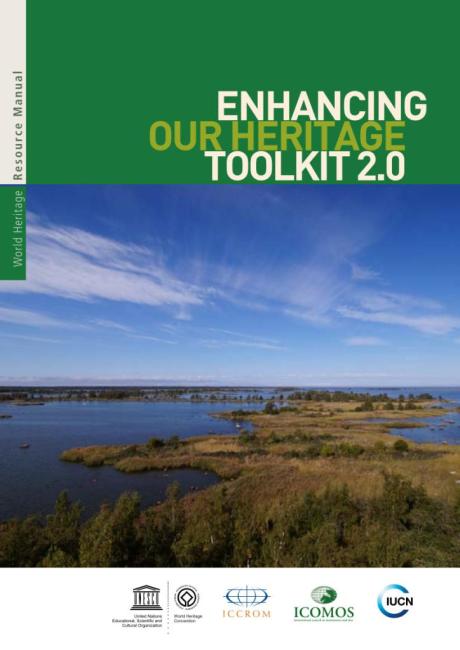Taking people-centred approaches to management
In the context of World
Heritage
All inherited assets which people value for reasons beyond mere utility. Heritage is a broad concept and includes shared legacies from the natural environment, the creations of humans and the creations and interactions between humans and nature. It encompasses built, terrestrial, freshwater and marine environments, landscapes and seascapes, biodiversity, geodiversity, collections, cultural practices, knowledge, living experiences, etc.
, communities are groups of people who have a connection to a heritage place and they can contribute to heritage management in a number of essential ways.
It is important to recognize the rights, knowledge, beliefs and capacities of Indigenous Peoples and other communities and provide meaningful ways to empower and ensure their participation in decision-making and other management processes.
States Parties
The countries which have adhered to the Convention Concerning the Protection of the World Cultural and Natural Heritage (
World Heritage Convention
The Convention Concerning the Protection of the World Cultural and Natural Heritage is an international treaty adopted by the UN in 1972 that defines the kind of natural or cultural sites which can be considered for inscription on the World Heritage List for their Outstanding Universal Value for all humankind. Commonly known as the World Heritage Convention, it establishes how the international community as a whole is responsible for
the protection of such heritage and sets out the duties of States Parties in identifying potential sites that may be eligible for inscription onto the World Heritage List and their role in protecting and preserving them. By signing the Convention, each country pledges to conserve not only the sites situated on its territory that have been recognized as being of Outstanding Universal Value, but also to protect its national heritage and to be involved in international efforts to protect, conserve and promote the heritage of humankind.
) (UNESCO, 1972).
are encouraged to adopt rights-based approaches in their World
Heritage
All inherited assets which people value for reasons beyond mere utility. Heritage is a broad concept and includes shared legacies from the natural environment, the creations of humans and the creations and interactions between humans and nature. It encompasses built, terrestrial, freshwater and marine environments, landscapes and seascapes, biodiversity, geodiversity, collections, cultural practices, knowledge, living experiences, etc.
processes and it is important to identify rights-holders in relation to World
Heritage
All inherited assets which people value for reasons beyond mere utility. Heritage is a broad concept and includes shared legacies from the natural environment, the creations of humans and the creations and interactions between humans and nature. It encompasses built, terrestrial, freshwater and marine environments, landscapes and seascapes, biodiversity, geodiversity, collections, cultural practices, knowledge, living experiences, etc.
, including Indigenous Peoples.

Figure 2.1 The interconnectedness of governance, management processes and results
States Parties
The countries which have adhered to the Convention Concerning the Protection of the World Cultural and Natural Heritage (
World Heritage Convention
The Convention Concerning the Protection of the World Cultural and Natural Heritage is an international treaty adopted by the UN in 1972 that defines the kind of natural or cultural sites which can be considered for inscription on the World Heritage List for their Outstanding Universal Value for all humankind. Commonly known as the World Heritage Convention, it establishes how the international community as a whole is responsible for
the protection of such heritage and sets out the duties of States Parties in identifying potential sites that may be eligible for inscription onto the World Heritage List and their role in protecting and preserving them. By signing the Convention, each country pledges to conserve not only the sites situated on its territory that have been recognized as being of Outstanding Universal Value, but also to protect its national heritage and to be involved in international efforts to protect, conserve and promote the heritage of humankind.
) (UNESCO, 1972).
to the
World Heritage Convention
The Convention Concerning the Protection of the World Cultural and Natural Heritage is an international treaty adopted by the UN in 1972 that defines the kind of natural or cultural sites which can be considered for inscription on the World Heritage List for their Outstanding Universal Value for all humankind. Commonly known as the World Heritage Convention, it establishes how the international community as a whole is responsible for
the protection of such heritage and sets out the duties of States Parties in identifying potential sites that may be eligible for inscription onto the World Heritage List and their role in protecting and preserving them. By signing the Convention, each country pledges to conserve not only the sites situated on its territory that have been recognized as being of Outstanding Universal Value, but also to protect its national heritage and to be involved in international efforts to protect, conserve and promote the heritage of humankind.
have committed to ensuring that cultural and natural heritage plays a function in the life of the community. Although it was a concern since the Convention’s inception, greater emphasis was placed on the role of communities in the implementation of the
World Heritage Convention
The Convention Concerning the Protection of the World Cultural and Natural Heritage is an international treaty adopted by the UN in 1972 that defines the kind of natural or cultural sites which can be considered for inscription on the World Heritage List for their Outstanding Universal Value for all humankind. Commonly known as the World Heritage Convention, it establishes how the international community as a whole is responsible for
the protection of such heritage and sets out the duties of States Parties in identifying potential sites that may be eligible for inscription onto the World Heritage List and their role in protecting and preserving them. By signing the Convention, each country pledges to conserve not only the sites situated on its territory that have been recognized as being of Outstanding Universal Value, but also to protect its national heritage and to be involved in international efforts to protect, conserve and promote the heritage of humankind.
with the adoption of a fifth strategic objective in 2007. The five Strategic Objectives of the
World Heritage Convention
The Convention Concerning the Protection of the World Cultural and Natural Heritage is an international treaty adopted by the UN in 1972 that defines the kind of natural or cultural sites which can be considered for inscription on the World Heritage List for their Outstanding Universal Value for all humankind. Commonly known as the World Heritage Convention, it establishes how the international community as a whole is responsible for
the protection of such heritage and sets out the duties of States Parties in identifying potential sites that may be eligible for inscription onto the World Heritage List and their role in protecting and preserving them. By signing the Convention, each country pledges to conserve not only the sites situated on its territory that have been recognized as being of Outstanding Universal Value, but also to protect its national heritage and to be involved in international efforts to protect, conserve and promote the heritage of humankind.
are Credibility, Conservation, Capacity Building, Communication and Communities, which are also known as the 5Cs.
The concept of ‘community’ differs from country to country and who belongs to a particular community is best defined by the members of that community themselves (who may feel a sense of belonging to multiple communities). However, in this context, community is used for groups of people who have a connection to a heritage place. This is not limited to legal rights; in some cases, communities have customary rights which sometimes are not formally documented and registered. In the context
of World Heritage, it is the ‘local’ community who is most frequently discussed, in reference to the groups of people who live in or near to a
World Heritage property
A cultural, natural or mixed heritage place inscribed on the World Heritage List and therefore considered to be of OUV for humanity. The responsibility for nominating a property to the World Heritage List falls upon the State(s) Party(ies) where it is located. The World Heritage Committee decides whether a property should be inscribed on the World Heritage List, taking into account the technical recommendations of the Advisory Bodies following rigorous evaluation processes.
When used as a general term, World Heritage refers to all the natural, cultural and mixed properties inscribed on the World Heritage List.
. However, there can be communities not physically located within or near to the heritage place but who have historic, cultural, spiritual or other connections. Some examples include a religious community associated with a sacred place, a community who has migrated, or a group of Indigenous Peoples who were forcibly displaced and thus have been physically disconnected from their ancestral lands or seas. It is also important to note that diverse communities associated with the same heritage place may accord it different significances and importance which may sometimes be in conflict with one another. Therefore having adequate working methods that can take on board participatory approaches can benefit management from the start, in resolving potential conflict and challenges.
Approaches to communities and their relationship to World Heritage have evolved over time and more people-centred approaches to heritage are now promoted. However, there is a sizeable legacy of past practices that did not prioritize people-centred and rights-based approaches. As the vital importance of communities has become more widely accepted, it has been recognized that they contribute in essential ways to World Heritage management namely by:
- ascribing values to heritage places;
- ensuring the persistence and continuation of attributes (such as carrying out traditional agricultural practices in a cultural landscape or undertaking religious ceremonies in a temple);
- providing inputs to, and participating in, planning and decision-making processes;
- carrying out maintenance, conservation works and other actions that contribute to the state of conservation of the heritage place;
- transmitting and maintaining traditional and Indigenous knowledge; and
- stimulating social relationships and investing in economic activities that generate benefits and contribute to the sense of place.
In recognition of the critical importance of participatory approaches to management, this manual has indicated in different units where communities can play an active role in the conservation and management of the heritage place, for example, in understanding its values (see 3.1), in governance (see 4.1) and various management processes (see 5). Community engagement is also an ethical duty; it is important to recognize the rights, knowledge, beliefs and capacities of Indigenous Peoples and communities and provide genuinely meaningful ways to empower and ensure their participation in decision-making and other management processes.
When considering the communities associated with World Heritage, it is important to distinguish those who are rights-holders. A commitment to human rights is included in the preamble to the United Nations Charter and the first article of the UNESCO Constitution. Under the Operational Guidelines,
States Parties
The countries which have adhered to the Convention Concerning the Protection of the World Cultural and Natural Heritage (
World Heritage Convention
The Convention Concerning the Protection of the World Cultural and Natural Heritage is an international treaty adopted by the UN in 1972 that defines the kind of natural or cultural sites which can be considered for inscription on the World Heritage List for their Outstanding Universal Value for all humankind. Commonly known as the World Heritage Convention, it establishes how the international community as a whole is responsible for
the protection of such heritage and sets out the duties of States Parties in identifying potential sites that may be eligible for inscription onto the World Heritage List and their role in protecting and preserving them. By signing the Convention, each country pledges to conserve not only the sites situated on its territory that have been recognized as being of Outstanding Universal Value, but also to protect its national heritage and to be involved in international efforts to protect, conserve and promote the heritage of humankind.
) (UNESCO, 1972).
are encouraged to adopt rights-based approaches in their World Heritage processes. The importance of adopting such approaches was explicitly affirmed in 2015 when the General Assembly of the
States Parties
The countries which have adhered to the Convention Concerning the Protection of the World Cultural and Natural Heritage (
World Heritage Convention
The Convention Concerning the Protection of the World Cultural and Natural Heritage is an international treaty adopted by the UN in 1972 that defines the kind of natural or cultural sites which can be considered for inscription on the World Heritage List for their Outstanding Universal Value for all humankind. Commonly known as the World Heritage Convention, it establishes how the international community as a whole is responsible for
the protection of such heritage and sets out the duties of States Parties in identifying potential sites that may be eligible for inscription onto the World Heritage List and their role in protecting and preserving them. By signing the Convention, each country pledges to conserve not only the sites situated on its territory that have been recognized as being of Outstanding Universal Value, but also to protect its national heritage and to be involved in international efforts to protect, conserve and promote the heritage of humankind.
) (UNESCO, 1972).
adopted the Policy on the Integration of a Sustainable Development Perspective into the Processes of the
World Heritage Convention
The Convention Concerning the Protection of the World Cultural and Natural Heritage is an international treaty adopted by the UN in 1972 that defines the kind of natural or cultural sites which can be considered for inscription on the World Heritage List for their Outstanding Universal Value for all humankind. Commonly known as the World Heritage Convention, it establishes how the international community as a whole is responsible for
the protection of such heritage and sets out the duties of States Parties in identifying potential sites that may be eligible for inscription onto the World Heritage List and their role in protecting and preserving them. By signing the Convention, each country pledges to conserve not only the sites situated on its territory that have been recognized as being of Outstanding Universal Value, but also to protect its national heritage and to be involved in international efforts to protect, conserve and promote the heritage of humankind.
. This policy includes a specific section on respecting, protecting and promoting human rights and makes it clear that
States Parties
The countries which have adhered to the Convention Concerning the Protection of the World Cultural and Natural Heritage (
World Heritage Convention
The Convention Concerning the Protection of the World Cultural and Natural Heritage is an international treaty adopted by the UN in 1972 that defines the kind of natural or cultural sites which can be considered for inscription on the World Heritage List for their Outstanding Universal Value for all humankind. Commonly known as the World Heritage Convention, it establishes how the international community as a whole is responsible for
the protection of such heritage and sets out the duties of States Parties in identifying potential sites that may be eligible for inscription onto the World Heritage List and their role in protecting and preserving them. By signing the Convention, each country pledges to conserve not only the sites situated on its territory that have been recognized as being of Outstanding Universal Value, but also to protect its national heritage and to be involved in international efforts to protect, conserve and promote the heritage of humankind.
) (UNESCO, 1972).
should:
- ensure that the full cycle of World Heritage processes from nomination to management is compatible with and supportive of human rights;
- adopt a rights-based approach, which promotes World Heritage properties as exemplary places for the application of the highest standards for the respect and realization of human rights;
- develop, through equitable participation of concerned people, relevant standards and safeguards, guidance tools and operational mechanisms for assessment, nomination, management, evaluation and reporting processes compatible with an effective rights-based approach for both existing and potential new properties;
- promote technical cooperation and capacity-building to ensure effective rights-based approaches.
The UN Declaration on the Rights of Indigenous Peoples (UNDRIP) adopted by the UN General Assembly in 2007 delineates and defines the individual and collective human rights of Indigenous Peoples, including their ownership rights to cultural and ceremonial expression, identity, language, employment, health, education and other issues. Their ownership also extends to the protection of their intellectual and cultural rights to own, use, develop and control the lands, territories and resources
they possess by reason of traditional ownership or other traditional occupation or use; their right to maintain, control, protect and develop their cultural heritage, traditional knowledge, and traditional cultural expressions, and their right to participate in decision-making affecting them. The UNDRIP also provides that states shall consult and cooperate in good faith with Indigenous Peoples in order to obtain their free, prior and informed consent (FPIC) before adopting and implementing measures that may affect them.
States Parties
The countries which have adhered to the Convention Concerning the Protection of the World Cultural and Natural Heritage (
World Heritage Convention
The Convention Concerning the Protection of the World Cultural and Natural Heritage is an international treaty adopted by the UN in 1972 that defines the kind of natural or cultural sites which can be considered for inscription on the World Heritage List for their Outstanding Universal Value for all humankind. Commonly known as the World Heritage Convention, it establishes how the international community as a whole is responsible for
the protection of such heritage and sets out the duties of States Parties in identifying potential sites that may be eligible for inscription onto the World Heritage List and their role in protecting and preserving them. By signing the Convention, each country pledges to conserve not only the sites situated on its territory that have been recognized as being of Outstanding Universal Value, but also to protect its national heritage and to be involved in international efforts to protect, conserve and promote the heritage of humankind.
) (UNESCO, 1972).
are equally encouraged to mainstream the UNESCO Policy on Engaging with Indigenous Peoples into their programmes and activities related to the
World Heritage Convention
The Convention Concerning the Protection of the World Cultural and Natural Heritage is an international treaty adopted by the UN in 1972 that defines the kind of natural or cultural sites which can be considered for inscription on the World Heritage List for their Outstanding Universal Value for all humankind. Commonly known as the World Heritage Convention, it establishes how the international community as a whole is responsible for
the protection of such heritage and sets out the duties of States Parties in identifying potential sites that may be eligible for inscription onto the World Heritage List and their role in protecting and preserving them. By signing the Convention, each country pledges to conserve not only the sites situated on its territory that have been recognized as being of Outstanding Universal Value, but also to protect its national heritage and to be involved in international efforts to protect, conserve and promote the heritage of humankind.
. This Policy calls for adequate consultations, the free, prior and informed consent and equitable and effective participation of Indigenous Peoples where nomination, management and policy measures of international designations affect their territories, lands, resources and ways of life.
This commitment to fostering rights-based approaches is now integrated into several paragraphs of the Operational Guidelines, where it is noted in particular that consideration and participation of rightsholders and stakeholders is encouraged in the processes of the following areas:
- Tentative Lists: participation and consultation of rights-holders when Tentative Lists are prepared, including obtaining the free, prior and informed consent of Indigenous Peoples in the case of candidate sites affecting their lands, territories or resources;
- Nomination processes: effective, inclusive and wide participation in the nomination process, including a clear demonstration that there has been the free, prior and informed consent of Indigenous Peoples;
- Management systems: an effective management system should include a thorough, shared understanding of the
World Heritage property
A cultural, natural or mixed heritage place inscribed on the World Heritage List and therefore considered to be of OUV for humanity. The responsibility for nominating a property to the World Heritage List falls upon the State(s) Party(ies) where it is located. The World Heritage Committee decides whether a property should be inscribed on the World Heritage List, taking into account the technical recommendations of the Advisory Bodies following rigorous evaluation processes.
When used as a general term, World Heritage refers to all the natural, cultural and mixed properties inscribed on the World Heritage List. , its universal, national and local values and its social-ecological context by all actors, including local communities and Indigenous Peoples as well as inclusive and participatory planning and consultation processes with respect for diversity, equity, gender equality and human rights. Collaborative management systems also include equitable governance arrangements and redress mechanisms to support the implementation of management activities.



